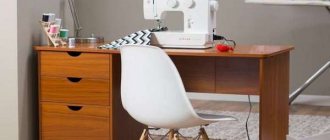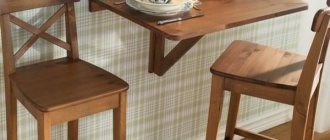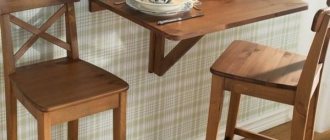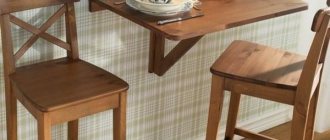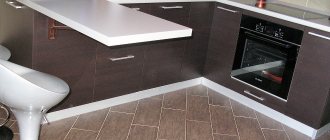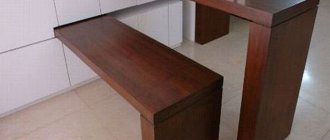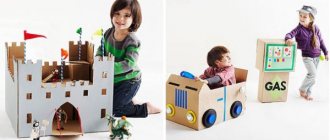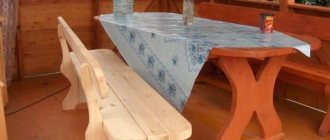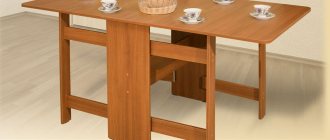table for a sewing machine
Happy owners of sewing machines cannot always enjoy their happiness to the fullest. It gets boring every time you take the typewriter out of the closet and set it on a table - a dining table or a desk, well, if not on a coffee table. But don’t rush to buy a special table; this article clearly shows that it’s a sewing table with your own hands . Limited space or budget or lack of experience will not be a hindrance. Here are the most affordable, low-cost options for tables for a sewing machine , as well as several examples of how to make a cutting table . Having your own sewing corner in an apartment is the dream of every housewife, but in modern small-sized apartments such a dream is unlikely to be realized. This article offers solutions for small spaces and modest budgets. Moreover, the tables were not made by professionals; most of the authors are very far from carpentry. This means that you will also definitely find here exactly your version of a table for sewing equipment .
Original ideas for organizing workspace in the home
To date, based on the requests of people involved in creativity, a large number of cabinets for needlewomen have been created. Depending on the purpose, transformable cabinets and tables are designed. Such furniture can embody all the whims of needlewomen. Pull-out cabinets, shelves, folding doors, etc. can help systematize the placement of certain creative items.
The assembled craft cabinet occupies a small living space and does not spoil the aesthetic appearance of the room. This furniture can be transformed into a work area in a short time.
The principle of folding “buffet” facades with compartments for small items
The cabinet table for handicrafts and sewing is equipped with special hinged doors. Strictly speaking, in terms of their functionality and design, they already become part of the body.
On the reverse side of the facades, an additional box is designed in which shelves and hangers are placed to accommodate various containers, reels, hangers and small tools. It can be folded in half or just like a book.
In its design, the book-shaped craft cabinet is very reminiscent of a kitchen buffet, which also often had shelves for storing various jars and bottles on the back of the facades. As, however, you can see it in the refrigerator.
By analogy, designers often design kitchen cabinets, pencil cases, inside of which there is a shelf that serves as a working surface for placing household appliances. Very convenient: small appliances are hidden from view and do not create visual noise in the kitchen interior. And at the same time it is always available for use.
A retractable tabletop can be made under the main work surface to provide greater ease of use.
However, DIY cabinets for handicrafts are rarely made to the same depth as kitchen cabinets. Therefore, it is not very rational to make retractable tabletops - after all, they can only be the same depth as the body of the craft cabinet. Therefore, a drawing of a cabinet for handicrafts and sewing can most often be seen with a folding tabletop and retractable legs, in the manner of a book-table.
Some needlewomen find it more convenient to use screw-in metal legs instead of folding supports - after all, they do not take away the depth of the lower shelves, and they can be stored in a separate section. And then the drawing for the cabinet, table for needlework and sewing can be drawn differently.
Book doors with shelves are attached to the base of the transformer cabinet with a folding table for needlework.
They can also be folded in half, then you can draw a transforming cabinet table with your own hands like this.
As can be seen in the drawing, it will be necessary to reduce the internal filling of the cabinet body to the depth of the “buffet” facades that fold inward. While the first level of folding doors with shelves increases the size of the external dimensions of the cabinet in depth.
Patchwork table: differences and important details
Not long ago I became interested in patchwork sewing. You can see my endeavors here. And this is the difference I discovered with the table for sewing clothes.
- Length may be shorter. It is a fact. A sewing table length of up to 110 cm is sufficient.
- The width may also be slightly smaller. About 60 cm is enough.
- Place for an iron. This is the most important difference. If when sewing clothes you simply place an ironing board nearby, then in patchwork sewing a hot iron should be at hand. Therefore, they make a place for ironing right on the table. I will tell you how to make a special ironing mat for a table later in a separate master class. To avoid missing out, subscribe to the news (right).
In patchwork, there are a lot of additional tools that need to be stored somehow. To save space in the apartment and give a corner to your husband, children, cats and dogs, you need to improve the sewing table.
Ikea sells excellent hooks with double-sided tape.
They can be used to cover a table and hang rulers. You can also sew bags for storing small items, and also place them on these hooks.
Manufacturing materials
When choosing a folding table for needlework, it is important to consider the weight and strength of the material from which it is made. Sewing tables often fold and unfold, which directly affects their durability and ease of use. In addition, in sewing you cannot do without an iron, the temperature from which can also affect the condition of the working surface.
The following types of materials are used to produce this furniture:
- Solid wood. By purchasing a sewing table made of this material, the master receives the most durable and wear-resistant working tool. This attribute will fit perfectly into the interior of any room. The array is not afraid of high temperatures, so you can place a hot iron on it. One of the disadvantages of such models is that wooden furniture is quite heavy and expensive.
- MDF. The main advantage of this material is ease of processing, light weight and low cost. Even an unskilled worker with a minimal set of tools can independently assemble a workplace from such material. MDF tables are often made on wheels, which provides good mobility, and the light weight of the furniture prevents scratching the floor covering. The disadvantages of MDF boards include fragility, fear of moisture and high temperatures. The coating of particularly cheap slabs can swell if you put a mug of boiling water on it, so you won’t be able to work with steam unless you add an additional protective coating.
- Chipboard. Perhaps the cheapest and most impractical material. Furniture made from chipboard has an attractive appearance, light weight, but is afraid of moisture and high temperatures, releases toxic substances and cannot withstand heavy loads.
- Chipboard. The optimal material for a sewing table is laminated chipboard. Pressed sawdust with the addition of special resins makes this material durable, environmentally friendly (subject to production standards), resistant to high temperatures, easy to process and, accordingly, quite cheap. A variety of materials will help you optimally fit the sewing machine table into any interior.
Although today laminated chipboard is the most popular material in the furniture industry, it has several significant disadvantages - it is afraid of water, formaldehyde may be released if it is not produced correctly, it is practically impossible to repair, it is relatively fragile and cannot withstand strong physical stress.
Chipboard
laminated chipboard
Solid wood
MDF
Other nuances of designing handmade cabinets
To equip book-folding facades, not ordinary furniture hinges are used, because they are convex, with their shoulder and bowl they will interfere with either filling the shelves or partitions. Mortise hinges are most often used.
Or piano, card loops. They can also be different, with installation on the end or the girth of the sidewall. When choosing, you need to correctly evaluate the optimal mounting location and the visibility of the mounting area when closed. Ideally, the loop is not visible at all: it is attached somewhere on the wrong, invisible side. If it is technically possible, of course.
You can read more about the types of furniture hinges and the differences here.
Also, when designing the internal filling of the doors of a handmade sewing closet, you need to have a clear idea of the sizes of all the accessories for the internal filling. Sometimes it’s a shame that in order to squeeze in another container or organizer, literally a centimeter is not enough. You can use ready-made office, kitchen, and cosmetic organizers.
Therefore, it is worth first deciding what storage containers, boxes and hangers, the very format of the stored materials will be built into the transformable table cabinet for needlework and sewing. And then, based on their size and the space occupied inside the shelves of your future workplace, start drawing drawings for the cabinets for handicrafts with your own hands.
What sizes can handicraft cabinets have and what do they depend on?
Firstly, a folding table imposes certain restrictions on the size of a craft cabinet.
If you want to use metal twist-out legs, they are 730mm long. To store them inside the cabinet, the cabinet itself must be about 800mm wide.
The dimensions should be approximately the same with folding supports, as in the first drawing with a tabletop depth of 500-600mm.
Otherwise, you can make the size of the handicraft cabinet the way you need it. Usually the height is set to about 1600-2000mm; higher shelves will no longer be available for storage without the use of a chair. In this case, the height of the tabletop is set at the level of the desktop - 750mm from the floor.
The depth of a craft cabinet with a folding transformer principle is usually calculated as follows: 300-350 is set for a fixed body and about 100-180mm for facades with shelves.
But it all depends on the storage systems that you plan to use for storage! You calculate the external dimensions based on what will be built inside the cabinet shelves and its facades.
What is important to consider?
If you sew clothes, then some parameters are important to you, and if you are into patchwork, then slightly different. Here I will split my note into two parts. But there are general parameters of a sewing table that are important for any type of needlework.
- Sustainability. Your table should not shake like a flabby vessel while the sewing machine is running. What do you need for a stable, strong sewing table? Your table should have an excellent article, i.e. legs. The best legs are thick, with a wide foot (what do you call the part on which everything stands?). In addition, the rear legs need to be fastened together with a common wall: this removes excess vibration.
- Smooth surface. Be sure to check that there are no holes, dents, or bulges on the surface of the sewing table. If suddenly your fabric is thin, then it will definitely show you all the clumsy places on the tabletop. Pay attention to the corners: check them for burrs and clumsy glues.
- Built-in cabinet. For your own convenience and saving space around your workplace, it is better to have a bedside table under the table. You can store various little things in it that will be at hand.
- Table height. Correct body position will deprive you of such joys as back pain, stiff neck, and arm fatigue. To understand how high a table you need, place your sewing machine somewhere and sit next to it. You should be comfortable working on the machine, without bending over it or reaching up. Measure from the floor to the machine and voila, your table height is determined.
